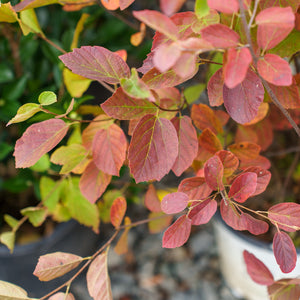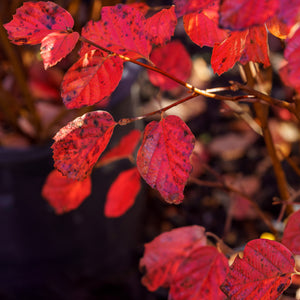The Fothergilla Guide
Fothergilla is a deciduous flowering shrub valued for its fragrant spring blooms, vibrant fall foliage, and naturalistic character. Native to the southeastern United States, Fothergilla offers four-season appeal with bottlebrush-like white flowers in spring, attractive green or blue-green summer foliage, and brilliant shades of orange, red, and yellow in autumn. Its dense, mounded growth habit and adaptability to varying conditions make it an excellent choice for woodland gardens, mixed borders, and native plant landscapes.
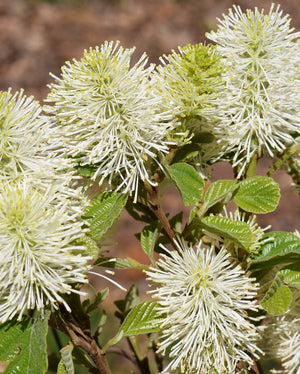
About
Fothergilla includes two primary species—Fothergilla gardenii (dwarf fothergilla) and Fothergilla major (large fothergilla)—as well as several outstanding cultivars and hybrids. Fothergilla gardenii typically grows 2 to 3 feet tall and wide, with a compact, rounded shape ideal for foundation plantings and small garden spaces. Fothergilla major is larger, often reaching 5 to 8 feet in height and width, and is better suited for mixed shrub borders or naturalized plantings.
Popular cultivars include ‘Blue Mist’ and ‘Suzanne’, both compact selections with soft blue-toned foliage. ‘Mount Airy’, a Fothergilla major cultivar, is known for its vigorous growth and exceptional fall color, while ‘Blue Shadow’ features powdery blue foliage that contrasts beautifully with its white spring flowers. Hybrid cultivars such as Fothergilla x intermedia ‘Legend of the Fall’ combine the best attributes of both parent species, including strong flowering, dense form, and consistent autumn color.
Fothergilla is a member of the witch hazel family and shares that genus’s signature combination of ornamental and ecological value. With its non-invasive root system, low maintenance requirements, and resistance to pests and disease, it’s an ideal shrub for long-term landscape performance.
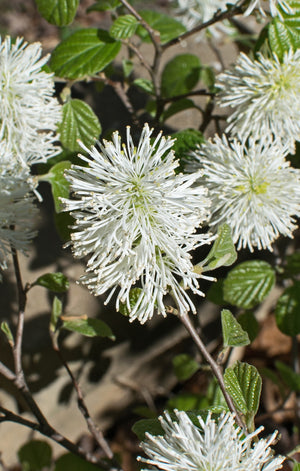
PLANTING
Fothergilla is easy to establish in well-chosen planting sites and rewards gardeners with years of low-maintenance beauty.
USDA Hardiness Zones: Hardy in Zones 4–8. Cold-tolerant and heat-tolerant varieties are available depending on species and cultivar.
Soil: Prefers moist, acidic, well-drained soil rich in organic matter. It can tolerate average garden soils but does not thrive in high-pH or heavy clay conditions.
Sunlight: Best performance is achieved in full sun to partial shade. In hot climates, afternoon shade is appreciated. Fall color tends to be more vivid in sunnier exposures.
Watering: Water regularly during the first growing season. Once established, Fothergilla is moderately drought-tolerant but benefits from consistent moisture, especially in sandy or fast-draining soils.
Spacing: Plant dwarf varieties like ‘Blue Mist’ and Fothergilla gardenii 2 to 3 feet apart. Larger selections like ‘Mount Airy’ or ‘Legend of the Fall’ should be spaced 5 to 6 feet apart to accommodate mature size.
Planting Time: Plant in early spring or fall. Fall planting allows roots to establish before winter dormancy, while spring planting takes advantage of the natural growing cycle.
CARE
Fothergilla requires minimal maintenance, making it ideal for both low-intervention landscapes and curated garden beds.
Watering: Provide regular watering during dry periods, especially in the first two years after planting. Avoid allowing the soil to dry out completely.
Fertilizing: Typically, no fertilization is necessary if planted in rich, organic soil. In poor soils, a light application of acid-loving plant fertilizer in early spring can support healthy growth.
Pruning: Prune immediately after flowering in late spring to maintain shape and size. Avoid heavy pruning, as Fothergilla naturally forms a pleasing mounded shape. Dead or damaged wood can be removed at any time.
Pests & Diseases: Fothergilla is rarely troubled by pests or disease. It is highly resistant to deer, and its native origin means it supports local biodiversity without attracting serious problems.
Mulching: Apply 2 to 3 inches of mulch in spring to conserve moisture and suppress weeds. Keep mulch several inches away from the base of the stems to avoid rot.
HOW TO USE
Fothergilla is an exceptional multi-season shrub that plays many roles in the landscape. Its spring flowers, fall foliage, and compact size make it highly versatile. Whether planted as a stand-alone specimen or integrated into a broader design, it delivers reliable beauty and ecological benefits.
Focal Point: Use cultivars like ‘Mount Airy’ or ‘Legend of the Fall’ as focal points in front-yard foundation beds or near garden entrances where their seasonal interest can be fully appreciated. The combination of fragrant spring blooms and vivid fall color draws attention from early spring through autumn.
Mixed Borders: Fothergilla integrates seamlessly into shrub and perennial borders. Pair with early bloomers like Virginia bluebells, bleeding heart, or hellebores to complement its bottlebrush flowers. Summer companions such as hostas, ferns, and astilbes provide lush foliage contrast. For fall drama, pair with red maples, oakleaf hydrangeas, or itea.
Woodland Gardens: Fothergilla thrives in partial shade and woodland settings, where its native character and low maintenance needs make it a perfect fit. Underplant with native groundcovers like foamflower (Tiarella) or woodland phlox for a naturalistic effect.
Foundation Plantings: Compact forms like ‘Suzanne’ and ‘Blue Mist’ are well-suited for planting along house foundations, patios, or walkways. Their tidy habit and limited height reduce the need for constant maintenance or pruning.
Pollinator Gardens: The fragrant, nectar-rich flowers attract bees and early-season pollinators. Combine with other native shrubs such as spicebush and clethra to create a layered pollinator-friendly border.
Erosion Control: Fothergilla's fibrous root system makes it a good option for stabilizing slopes and embankments. Plant in groups to cover larger areas and reduce surface runoff while still enjoying seasonal ornamental appeal.
Rain Gardens: While not tolerant of consistently soggy soil, Fothergilla does well in rain garden edges or moist but well-drained sites where it can benefit from intermittent water flow.
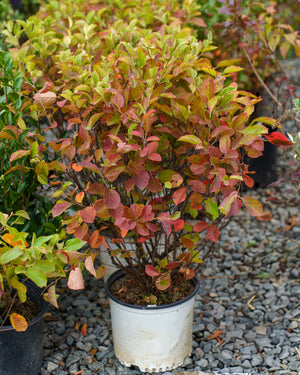
Common Questions
Are fothergilla deer resistant? Yes. Fothergilla is considered deer resistant and is rarely browsed, making it a dependable choice in landscapes with high deer pressure.
How to prune fothergilla? Prune immediately after flowering to lightly shape the plant or reduce size. Avoid cutting back hard, as this can ruin its natural form. Remove dead or damaged branches as needed.
Is fothergilla native? Yes. Fothergilla species are native to the southeastern United States, making them excellent additions to native plant gardens and pollinator-friendly designs.
Is fothergilla poisonous to dogs or cats? There are no known reports of toxicity to dogs or cats, but as with any plant, ingestion may cause mild stomach upset. It is generally considered pet-safe.
Do rabbits eat fothergilla? Fothergilla is not a preferred food for rabbits. While young plants may be occasionally nibbled, mature shrubs are typically left alone.
When does fothergilla bloom? Fothergilla blooms in mid to late spring, usually April to early May, depending on the region. Flowers appear before or as the leaves begin to emerge.
Are bees attracted to fothergilla flowers? Yes. Fothergilla’s fragrant, nectar-rich blooms are highly attractive to bees and early-season pollinators.
Can fothergilla be used for erosion control? Yes. Fothergilla has a fibrous root system that helps stabilize soil, especially on slopes or naturalized sites.
Can fothergilla grow in shade? Fothergilla grows well in partial shade and tolerates dappled woodland conditions. It may flower less heavily in deep shade, but it remains a reliable foliage plant.
Do fothergilla tolerate wet feet? Fothergilla does not tolerate prolonged wet or saturated soil. It prefers moist but well-drained conditions and may suffer in poorly drained sites.
Conclusion
Fothergilla is a truly four-season shrub, offering fragrant spring flowers, lush summer foliage, spectacular fall color, and attractive winter form. Native, non-invasive, and pollinator-friendly, it combines ecological value with ornamental charm. Whether used as a focal point, grouped in mass plantings, or integrated into woodland borders, Fothergilla delivers consistent beauty with minimal care, making it a standout addition to any garden or landscape design.
The Fothergilla Collection
Sold Out
Sold Out
Sold Out
Sold Out



